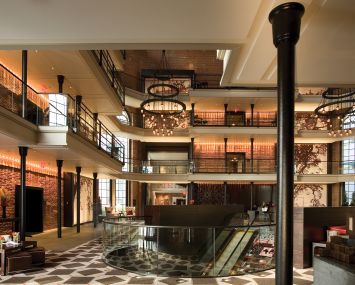One Wall Street Serves as Test Case for Other Office Conversions Post-COVID
Will it make money for its builders? And how replicable is it?
By Celia Young March 16, 2023 7:00 am
reprints
They say those who can’t remember the past are doomed to repeat it. But for Harry Macklowe, One Wall Street’s past allowed him to reinvent it.
Macklowe bought the Art Deco former office tower for $585 million from Bank of New York Mellon Corporation in 2014. Seven years, a pandemic and millions of dollars later, the octogenarian has mostly wrapped construction on the 1.17 million-square-foot property’s 566 condominiums, just in time for one of the biggest pushes for office-to-residential conversions in the past 20 years.
With New York City facing an office glut and housing shortage, One Wall serves as one of the biggest physical examples of how conversions could tackle those two issues, though it remains to be seen how long it will take for its condos to sell out. For Macklowe, One Wall’s unique history and design lent it to a residential conversion, but the rest of New York City’s struggling office crop might not be so lucky.
Built in the 1930s, One Wall Street was designed by famed architect Ralph Thomas Walker as the home of the Irving Trust Company, before becoming the home of the Bank of New York Mellon. As the bank downsized in New York City, Macklowe, bouncing back from the 2008 financial crisis, scooped up the landmarked building and announced plans to build mostly luxury apartments at the tower. He pivoted in 2017 toward condominiums among a softening rental market, Bloomberg reported at the time.
Oh, how the tables turn.
Today, the mostly finished tower melds its 1930s past with a very luxurious future. Its lowest-priced studio, as of March 6, was $1.13 million, Matthew Chook, senior vice president of sales for One Wall, told Commercial Observer. For a four-bedroom, Macklowe is asking $12.75 million, and four units in the building have not yet been priced, including the penthouse, Chook added. (Reports a year ago in the New York Post said $40 million was the rumored penthouse price; Spear’s magazine reported $75 million last month.)
Building those units wasn’t exactly easy, said Dan Shannon, principal of MdeAS Architects, the interior architects on One Wall Street. The elevator system needed to be rebuilt to accommodate residential owners, who travel at different times than office workers. One Wall also needed to negotiate with the New York City Landmarks Preservation Commission regarding the amount of outdoor space it could provide to owners.
But One Wall also benefited from its office past. All of its windows could be opened, a feature that helped circulate air into the building, which was constructed before modern air conditioning. For that same reason, the distance from the building’s core to its exterior windows is shorter than in a more modern office building, allowing One Wall to be converted without having to carve out oddly shaped residential units. And, for units deeper in the building, Macklowe was able to add windowless home office space, right in time for a huge work-from-home trend thanks to the pandemic, Shannon said.
Of course, One Wall has AC now. And a pool. And a 6,500-square-foot private coworking space. The amenity list goes on: Residents get complimentary memberships to Life Time’s 74,000-square-foot fitness center at the base of the building, plus easy access to French department store Printemps’ 54,365-square-foot outpost and a 44,000-square-foot, two-floor Whole Foods grocery store. (In one studio, you can actually watch people walk in and out of Whole Foods’ entryway, while in another unit you can peer through the New York Stock Exchange’s windows.)
Those amenities, plus the building’s landmark status, have helped get sales off the ground despite a tougher residential market, Chook said.
“The market hasn’t been great, let’s be blunt,” Chook said. “But the fact that we are doing so well seems to defy, frankly, a lot of what we’re seeing or at least hearing in the marketplace. … The feedback that we get is that we’re doing significantly better than any of the other projects that [our sales and marketing agents] are representing.”
Closings at One Wall Street are imminent, indicating that at least 15 percent of the units are in contract, The Real Deal reported. Most of One Wall’s buyers were those who planned to use the building as their primary residence, usually in a relocation from the Financial District or the Upper East or Upper West sides. One Wall has also seen a handful of international buyers and parents scooping up units for their college-age or young professional children. (As they say in journalism: If your mother says she loves you … ask her to prove it with a million-dollar luxury condo.)
One Wall officially started welcoming new residents into the building this month, but it may take a while for all its units to sell. A similar project in Tribeca, The Woolworth Building, was converted into 32 lavish condos by Alchemy Properties, but eight years after sales launched it still has one unit left on the market: a top-floor space dubbed “The Pinnacle” by Alchemy’s head Kenneth Horn. (Horn said he was actively negotiating a deal for the unit, but couldn’t share more.)
Sales at One Wall launched in 2021, and the building, in all its amenity-heavy glory, wasn’t cheap. Macklowe spent $850 per sellable square foot for the office building, TRD reported. (It’s worth noting that, when considering the building’s total size, Macklowe paid $500 per square foot.)
Deutsche Bank provided $806 million in construction financing for the property in 2018, and Macklowe went after a $1.1 billion debt package to refinance the building with his equity partner, Hamad bin Jassim bin Jaber Al Thani of Qatar Royal. A source close to the deal said Deutsche Bank’s private bank division would refinance the debt, giving Macklowe and Al Thani time to sell out the condo.
That also leaves time to see whether Macklowe makes back the reported $2.3 billion cost of constructing the tower. If all goes according to plan, New York will have gained 566 new homes, lost one office building, and Macklowe will have made history with one of the largest conversion projects in the city.
But the success of One Wall won’t necessarily herald a new wave of conversions.
“We’re in an incredibly distressed office market, more distressed than I think anyone ever thought you would have,” said Max Herzog, a senior managing director at JLL’s capital markets team who finances office conversions. “Because of some of the obstacles, there’s certainly going to be more office-to-apartment or even condo conversions than ever before, but there’s still not going to be that many.”
Conversion projects are expensive, time-consuming and complex. You need a building with smaller floorplates, window access and the right (or amendable) zoning, said Maren Reepmeyer, vice president at the architecture and design firm SGA. You have to buy it vacant, or buy out office tenants, and often you must upgrade the elevators, mechanicals and exits, and add outdoor space, she added.
Plus, the cost of capital is higher. Still, starting with inexpensive office space — ideally a property priced at less than $400 a square foot and depending on its location — can make up the difference, Herzog said.
“Your cost of capital is higher and construction costs are higher,” Herzog said. “But, again, I think it’s mitigated for the most part. You can still generate similar returns by the fact that you can buy an office building cheaper than even land right now to convert it, and rents are higher than they’ve ever been on the apartment side.”
Condo conversion projects like One Wall Street also don’t exactly solve the city’s lack of affordable housing, unless you count million-dollar residences as affordable. But other rental conversions could someday see new tax incentives that would make office conversions more affordable and more beneficial for the city.
Gov. Kathy Hochul included a provision in her state budget, which must be approved by April 1, to revise New York’s multiple dwelling law to aid office building conversions in Manhattan south of 60th Street, The City reported. New York Mayor Eric Adams recommended in January changing state and city zoning requirements to make conversion regulations more flexible on 136 million square feet of office space, according to the mayor’s office. And organizations like the Five Boroughs Housing Movement are pushing state lawmakers for conversions, said John Sanchez, executive director of the organization.
“Not every office will convert nor would we want every office to convert because commercial property taxes are a large source of revenue for New York City,” Sanchez said. “[But] because the housing crisis is so dire, we should look at every avenue. … We need every tool in the toolbox.”
One Wall Street, for its part, proves that it’s possible today to convert an office tower to a residential one at a massive scale. It has not yet proven that it’s profitable, and the debate is open on whether it’s practical. It is certainly a tool in the toolbox. And quite a gorgeous one at that.
Celia Young can be reached at cyoung@commercialobserver.com.


